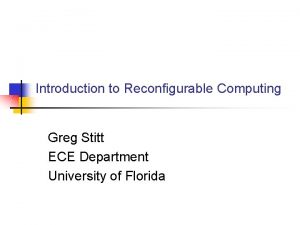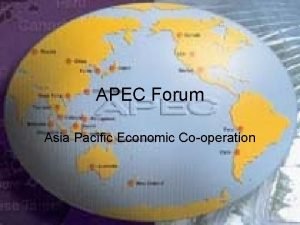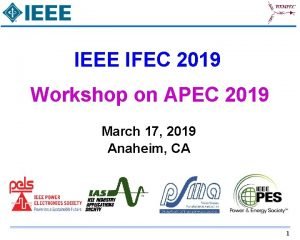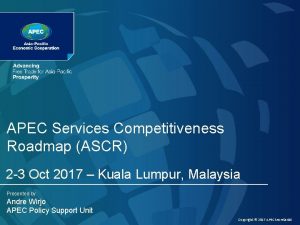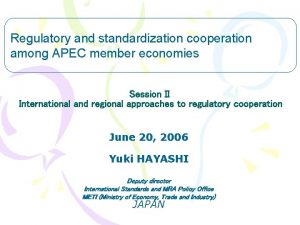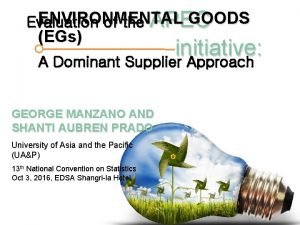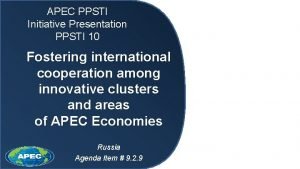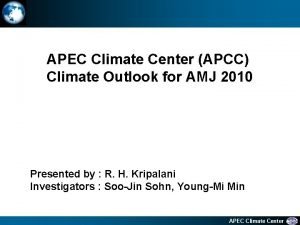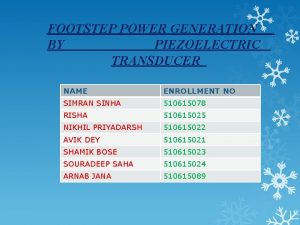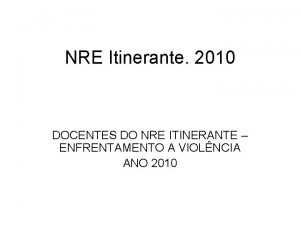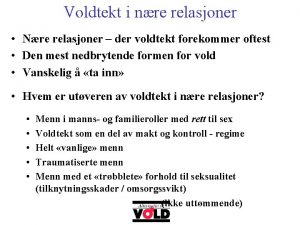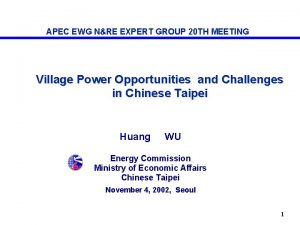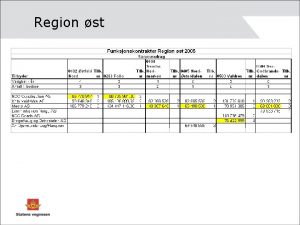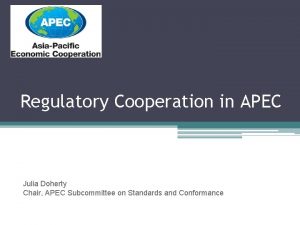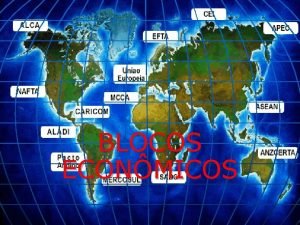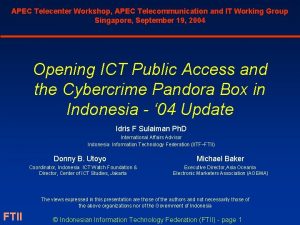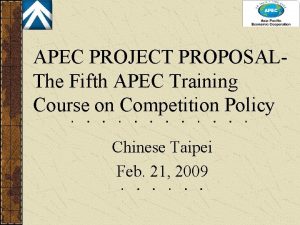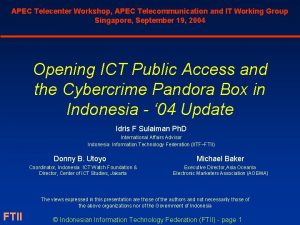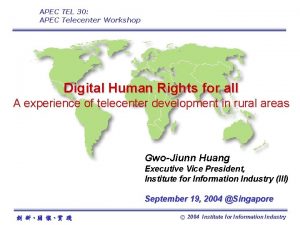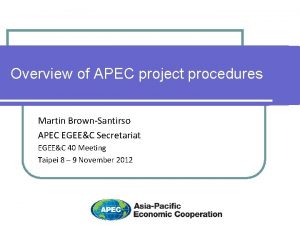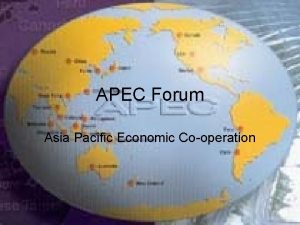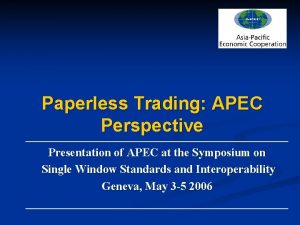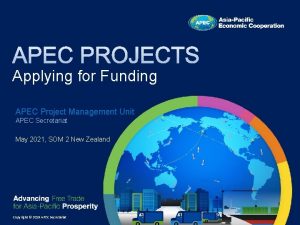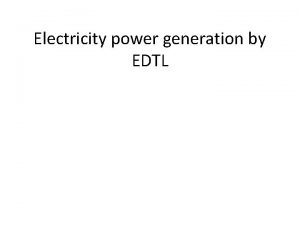NRE for Power Generation in the APEC Region














































- Slides: 46

NRE for Power Generation in the APEC Region – Preliminary Findings APEC New and Renewable Energy Technologies Expert Group Meeting Twenty-Second Meeting 12 -13 May, 2004 Jaya Singam Rajoo Asia Pacific Energy Research Centre, Tokyo

Outline • Objectives • Current Status of PV and Wind Technologies for Power Generation • Historical Growth : Wind and PV Technology Demand • Role of NRE in Power Generation • Applications in Niche Market • Policy Measures to Boost NRE Utilisation • Initial Conclusions

Objectives § Identify the role of NRE technologies for power generation in the APEC region § Estimate the NRE resources and potentials in APEC region § Establish the potential applications of NRE in meeting electricity demand in APEC region § Examine policy measures to promote NRE utilisation in APEC power sector

Current and Projected Status of NRE Technologies for Power Generation in APEC Region Business As Usual (BAU) Scenario 40, 000 NRE’s share-2. 38% in 2050 35, 000 30, 000 Biomass, wind, solar & others TWh 25, 000 Geothermal Hydro 20, 000 Oil-Based Nuclear Natural Gas 15, 000 Coal Steam 10, 000 5, 000 0 1999 2005 2010 2015 2020 2025 2030 2035 2040 2045 2050

Installed Wind Capacity in Selected APEC Economies USA has 6, 374 MW or 82% of the Total APEC Installed Wind Capacity in 2003 1600 7, 716. 6 1400 Malaysia Indonesia Megawatts (MW) 1200 Chile Chinese Taipei 1000 Mexico Russia 800 3, 266. 8 Korea New Zealand 600 Japan China 400 Canada Australia 200 1, 645. 2 0 1993 2000 2003 Source : AWEA

Growth Trend: Installed Wind Capacity for Selected APEC Economies 7000 6000 MW 5000 4000 3000 2000 1000 0 1993 1994 1995 1996 1997 1998 1999 2000 2001 2002 Australia Canada China Japan Korea Mexico New Zealand United States 2003 Source : AWEA

Growth Trend: Installed Wind Capacity for Selected APEC Economies 1400 1200 MW 1000 800 600 400 200 0 1993 Australia 1994 1995 Canada 1996 China 1997 Japan 1998 1999 Korea 2000 Mexico 2001 2002 2003 New Zealand

The cost of wind power in favourable wind regime declined by 47% between 1990 and 2000 and may decline another 38% by 2010 35 30 US cents/k. Wh 25 20 15 10 5 0 1980 1990 Canada 1995 2000 USA High Wind Speed 2005 2010 Europe High Source : AWEA

Current Status of Wind Technology § Wind capacity grew 14% annually in APEC and 33% per year globally from 1993 -2003 § Highest annual growth in New Zealand with 67% (albeit small base) followed by Japan-54%, Australia-44%, Canada-32% and China-29% § Key issue – how long can this rapid growth continue?

Current Status of Wind Technology § Technical constraint – intermittent resource limits share to 20% of total generation § The best wind resources with lowest generating costs are often distant from load centres. Substantial scale may be needed to allow economical transmission over HV line § Growth concentrated in industrialised economies with favourable policies and economic incentives

Wind Technology Boosters § The US has supported wind R&D for about two decades, in FY 2003 it totalled US$43. 4 million § Renewable Portfolio Standards - currently in 16 states § Cost reduction of 50% in the last 10 years due to - high growth in demand - fast improving technology - various policy measures and incentives § Other incentives -PTC of 1. 5 cents/k. Wh for first 10 years of operation since 1992 to 2003, extension still pending, rebates up to 50% of cost of small turbine (residential) in California

Wind Technology in Developing Economies § Poorer economies are particularly sensitive to costs and cannot offer financial incentives § May require assistance to map their wind resources – China, Indonesia, Mexico, Philippines and Vietnam had assistance from NREL § In rural areas of developing economies without established power grids, stand-alone wind system are not a practical option § There may be some potential for combined wind/diesel hybrid system in rural applications with favourable wind regime

The US has excellent wind resources within 100 km of major cities like Chicago and Minneapolis Washington Montana N. Dakota Minnesota Oregon Wyoming Iowa Colorado California Kansas Tennessee Texas Source : Montanagreenpower. org

China has excellent wind resources in Anhui, Hubei and Jiangxi Provinces Area covered : 4, 000 km 2 Good to Excellent Wind at 30 m – 73, 500 GWh/yr Moderate to excellent – 113, 900 GWh/yr Source: NREL

Measuring Solar Insolation April 1984 -1993 January 1984 -1993 Average annual irradiation on earth – 19 Trillion toe Current annual requirement – 9 Billion toe Source: Earth Observatory, NASA

Average Solar Radiation in USA for July The dots represent the 239 sites of the National Solar Radiation Database (NSRD) Source: NREL Resource Assessment Program

Average Solar Radiation in USA for January The dots represent the 239 sites of the National Solar Radiation Database (NSRD) Source: NREL Resource Assessment Program

Annual Addition to Photovoltaics (PV) Capacity Grew over 4 -fold worldwide from 1993 -2000 Source: World Energy Council

Installed Photovoltaics (PV) Capacity in APEC Region Installed capacity tripled in Japan from 1999 -2003 700 600 Megawatts (MW) 500 JPN USA 400 AUS MEX 300 CAN ROK 200 100 0 1992 1993 1994 1995 1996 1997 1998 1999 2000 2001 2002 Source: IEA-PVPS

Installed PV Capacity by Applications in Selected APEC Economies, 2002 700 Rooftop in Japan, mixed uses elsewhere 600 Megawatts (MW) 500 400 300 200 100 0 AUS CAN JPN KOR MEX USA Off-grid domestic [MW] Off-grid non-domestic [MW] Grid-connected distributed [MW] Grid-connected centralized [MW] Source: IEA-PVPS

Application Share from Total Installed PV Capacity in Selected APEC Economies, 2002 Mostly off-grid applications except in Japan 100% 90% 80% 70% 60% 50% 40% 30% 20% 10% 0% AUS CAN JPN KOR MEX Off-grid domestic [MW] Off-grid non-domestic [MW] Grid-connected distributed [MW] Grid-connected centralized [MW] USA Source: IEA-PVPS

Installed PV Capacity in S. E. Asia, 2002 Still very limited, mostly off-grid application. Focus on rural villages without power grid 6000 5000 Kilowatt (k. W) 4000 3000 2000 1000 0 Indonesia Malaysia Vietnam Thailand Philippines Source: ACE

Current Status of PV Technology in APEC Region Major cost reductions have occurred. Further reductions are anticipated as production scale economies are achieved § Annual growth rate of about 33% from 1971 -2000 § Total installed capacity still low – around 930 MW § Costs are still very high (~ US$0. 60 per k. Wh) but are expected to decline substantially to US$0. 30~0. 40 by by 2020 § Mostly utilised for off-grid applications (e. g. highway lighting, remote villages) § Distributed rooftop applications – huge in Japan and will be the next major market by reducing balance of system costs by combining PV modules with roof tiles

Current Status of PV Technology in APEC Region § The rooftop market still relies on subsidy for demand stimulation -69 billion Yen from 1994 -2000 covering 57, 000 residential systems in Japan (210 MW) -16. 8 billion Yen from 1992 -2000 covering 495 public and commercial facilities (13. 5 MW) § Large-scale grid applications will require further sharp cost reduction and intermittent sources like PV would be limited to about 20% of total generation even when cost-effective

Financial Incentives for PV Technology In US the form of subsidy varies according to State Some of the “incentives” offered in California include: a) State rebate programmes – offering $3~4/W for residential installations b) Utility rebate programmes are more generous for both residential and commercial facilities. Rebates ranges from 50% of first panel or ~5/W for both residential and commercial installations

PV Applications in China § PV systems installed in 600, 000 1995 -2003 with assistance from GEF § PV production capacity will soon expand from 5 MW to 80 MW per year largely directed at export market § Total installed PV capacity should reach 100 MW by 2010, 80% for rural electrification § Goal : 24, 000 village PV hybrid system by 2004 § Rooftop demonstrated in Beijing and Shenzen

PV Applications in Thailand § Battery charging station – 2 MWp § Telecommunications – 1. 5 MWp § Water pumping – 1. 13 MWp § Hybrid grid-connected – 313 k. Wp § Remote schools – 226 k. Wp § SHS – 195 k. Wp (18, 000 k. W by 2005) § Others – 500 k. Wp § Future Targets - 300, 000 SHS with 120 Wp each, to complete by 2006 - 50 MW urban rooftop application by 2011

PV Applications in Indonesia § Total installed capacity – 5 MW § SHS – more than 25, 000 unit with capacity of 45 Wp each had been installed § Targets – 2, 750 new homes to be installed in 2004

PV Applications in Philippines § Initiated in 1980 s under the Philippines-German Solar Energy Programme § Solar Home System (SHS)– around 3, 600 system had been installed to date § Total installed capacity – less than 1 MW § More than 5 million household unelectrified, great potential for more SHS § Goal – 40, 000 to 60, 000 SHS by 2006 § Telecommunications – currently 119 systems for relay stations with an installed capacity of 94 Wp § Water pumps – 126 systems with a capacity of 175 Wp has been installed

PV Applications in Malaysia § SHS – 2. 2 MW rural infrastructure § Telecommunications – 73 k. Wp § Water pumping – 10 k. Wp § Navigation – 2 k. Wp have been installed so far including lighthouse, maritime beacon § NEDO supported project – 100 k. W (Diesel hybrid system) to supply rural village in Sabah

Niche Market RURAL ELECTRIFICATION § More than 230 million people in APEC have no access to electricity § Rural population distribution in some economies render grid extension infeasible § PV and wind technology in combination with diesel/battery provide a better alternative in these conditions § Electricity supply have significant impact on rural communities by stimulating economic development and improving quality of life

Niche Market AGRICULTURE § Significant percentage of population is involved in agricultural activities in developing economies of APEC § NRE technologies can be utilised in the agriculture sector - PV and Wind water pumping system - Solar drying

Niche Market OTHER APPLICATIONS § Powering rural schools § Refrigeration of medicine/vaccines in rural health facilities § Communications § Transportation/navigation § Streetlights

Policy Options Demand Pull Strategies Financial Incentives Market Facilitation and Investment Rural Electrification Policy Distributed Generation Policy

Policy Options Demand Pull Strategies § Renewable Portfolio Standards § Non-Fossil-Fuel-Obligation (UK, 1990 -1997) § Feed-in Tariffs (resulted in 8, 500 MW of installed wind from 1991 -2001 in Germany) § Green certificate (US, Australia, UK, Denmark & Belgium)

Policy Options Financial incentives § Subsidies and rebates (Sunshine Programme -Japan, “Million solar roofs”- US) § Tax relief (Investment tax credits, accelerated depreciation, production tax credits, property tax incentives, personal income tax incentives, sales tax incentives, pollution tax exemptions, etc) § Grants § Loans (varies in amount – residential, industrial) commercial and

Policy Options Market facilitation and investment § Carbon tax, System Benefits Charge § NRE access laws (allows property owners to access NRE resources) § Infrastructure policy § Government procurement § Public awareness programme

Policy Options Rural Electrification Policy § Energy Service Concession § Microcredit and Rural Business Development § Line extension Analyses

Policy Options Distributed Generation Policies § Real-time pricing § Net metering § Interconnection Regulation

APEC Power Generation, 1999 -2050 An illustration based on 10% RPS in APEC 40, 000 NRE - 4. 7% 35, 000 30, 000 Biomass, wind, solar & others TWh 25, 000 Geothermal Hydro 20, 000 Oil-Based Nuclear Natural Gas 15, 000 Coal Steam 10, 000 5, 000 0 1999 2005 2010 2015 2020 2025 2030 2035 2040 2045 2050

Assumptions 1. Only in economies with GDP/capita of US$10, 000 or more by 2030 2. 10% increase – with 2. 5% for every 5 years starting from 2035 3. Hydro is excluded 4. Excluding existing share of non-hydro NRE in 2034

APEC Power Generation by Fuel Share An illustration based on 10% RPS in APEC 40, 000 35, 000 Geothermal 30, 000 Hydro TWh 25, 000 Natural Gas 20, 000 Nuclear 15, 000 Oil-Based 10, 000 Coal Steam 5, 000 Biomass, wind & solar 0 2000 2010 2020 2030 2040 2050 Source: APERC 2004

Avoided Annual CO 2 Emission An illustration based on 10% RPS in APEC 400 182 20 350 300 357 MT 250 N. Gas 200 Oil 150 Coal 100 50 0 2035 2040 2045 2050 Source: APERC 2004

Annual Total Fuel Saved with 10% RPS An illustration based on 10% RPS in APEC 2035 2040 2045 Coal (tonnes) 27. 87 61. 15 97. 15 133. 47 Oil (mil bbls) 4. 38 16. 98 30. 48 44. 48 Gas (BCM) 15. 17 33. 91 54. 15 74. 56 Source: APERC 2004 2050

Preliminary Conclusions • Non-hydro NRE would have a modest impact on the overall electricity industry • Current growth in NRE is dependent on favourable state “incentives” in the short term • Sound policy measures and economic incentives are vital for deployment of emerging technologies such as PV

Preliminary Conclusions • Difficult to duplicate in developing economies without support from developed economies • In most cases, NRE took off only with initial bilateral/international financial support
 Greg stitt
Greg stitt Nre de cascavel
Nre de cascavel Na alternância entre minha e vossa
Na alternância entre minha e vossa Stahl
Stahl Oh lord you are good and your mercy endureth forever
Oh lord you are good and your mercy endureth forever Draw the power triangle
Draw the power triangle Apec project guidebook
Apec project guidebook Apec
Apec Apec mapa
Apec mapa Importancia del apec
Importancia del apec Apec 2019
Apec 2019 Apec services competitiveness roadmap
Apec services competitiveness roadmap Apec
Apec Prospekting
Prospekting Apec food safety cooperation forum
Apec food safety cooperation forum Apec
Apec Apec
Apec Apec
Apec Apec environmental goods
Apec environmental goods Apec ppsti
Apec ppsti Apcc climate
Apcc climate Clavipectoral fascia
Clavipectoral fascia Active region and saturation region
Active region and saturation region Disadvantages of foot step power generation
Disadvantages of foot step power generation Power generation forging
Power generation forging Mhd power generation ppt
Mhd power generation ppt Kontinuitetshantering
Kontinuitetshantering Novell typiska drag
Novell typiska drag Nationell inriktning för artificiell intelligens
Nationell inriktning för artificiell intelligens Vad står k.r.å.k.a.n för
Vad står k.r.å.k.a.n för Varför kallas perioden 1918-1939 för mellankrigstiden
Varför kallas perioden 1918-1939 för mellankrigstiden En lathund för arbete med kontinuitetshantering
En lathund för arbete med kontinuitetshantering Särskild löneskatt för pensionskostnader
Särskild löneskatt för pensionskostnader Tidbok yrkesförare
Tidbok yrkesförare A gastrica
A gastrica Densitet vatten
Densitet vatten Datorkunskap för nybörjare
Datorkunskap för nybörjare Stig kerman
Stig kerman Debattinlägg mall
Debattinlägg mall Delegerande ledarskap
Delegerande ledarskap Nyckelkompetenser för livslångt lärande
Nyckelkompetenser för livslångt lärande Påbyggnader för flakfordon
Påbyggnader för flakfordon Lufttryck formel
Lufttryck formel Offentlig förvaltning
Offentlig förvaltning Kyssande vind
Kyssande vind Presentera för publik crossboss
Presentera för publik crossboss Argument för teckenspråk som minoritetsspråk
Argument för teckenspråk som minoritetsspråk
